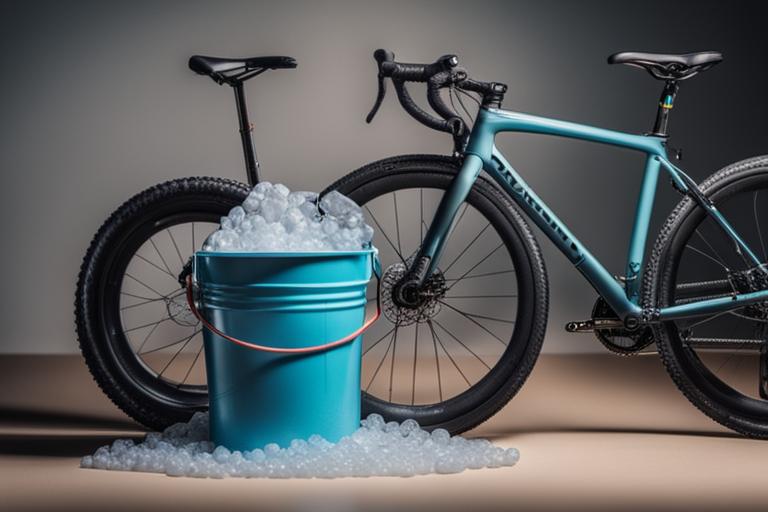Learn How to Wash a Bike Like a Pro
By reading this article, you will learn:
– Why it’s important to wash your bike regularly and the benefits of proper maintenance.
– The necessary supplies and step-by-step techniques for cleaning different parts of your bike effectively.
– The importance of inspecting your bike and proper storage after washing.
If you’re wondering “how to wash a bike,” you’re in the right place. Bike maintenance is crucial, and regular washing is a key aspect. Not only does it keep your bike looking clean and shiny, but it also plays a crucial role in the overall maintenance and longevity of your bike. In this article, we provide expert tips and techniques on how to wash your bike like a pro.
Importance of regular bike washing
Regular bike washing is crucial for several reasons. It helps keep your bike in good condition by removing dirt, grime, and other contaminants that can accumulate over time, especially if you frequently ride in muddy or dusty environments. By regularly washing your bike, you can prevent these contaminants from causing damage to your bike’s components.
Benefits of proper bike maintenance
Proper bike maintenance, including regular washing, goes beyond just aesthetics. It involves regularly checking and maintaining various components of your bike to ensure optimal performance and safety. By incorporating regular bike washing into your maintenance routine, you can extend the lifespan of your bike, maintain its optimal performance, and save money on costly repairs in the long run.

Why Wash Your Bike?
Preventing rust and corrosion
Regular bike washing helps prevent rust and corrosion. When dirt, mud, and moisture accumulate on your bike’s frame and components, they can lead to the formation of rust, which not only looks unsightly but can also weaken your bike’s structure and affect its performance. By washing your bike regularly, you can remove these corrosive elements and protect your bike from rust.
Extending the lifespan of your bike
A well-maintained bike is more likely to last longer. Regular washing helps remove dirt, grime, and other contaminants that can cause premature wear and tear on your bike’s components. By keeping your bike clean, you can prevent these contaminants from causing damage and extend the lifespan of your bike.
Maintaining optimal performance
A clean bike performs better. When dirt and grime accumulate on your bike’s drivetrain, it can affect the smoothness of gear shifting and overall performance. By regularly washing your bike and keeping the drivetrain clean, you can ensure optimal performance on your rides.

Gathering Necessary Supplies
Before you begin washing your bike, it’s important to gather all the necessary supplies. Here are the items you’ll need:
Bucket
A bucket is essential for holding water and bike cleaner during the washing process. Make sure to choose a bucket that is large enough to accommodate your cleaning tools and has a sturdy handle for easy maneuverability.
Bike-specific cleaner
Using a bike-specific cleaner is recommended as it is designed to effectively remove dirt and grime without damaging your bike’s paint or components. Look for a cleaner that is biodegradable and environmentally friendly.
Sponge or brush
You’ll need a sponge or brush to scrub away dirt and grime from your bike’s frame, wheels, and other components. A soft-bristled brush or a sponge with a non-abrasive surface is ideal to prevent scratching.
Hose or water source
A hose or a steady supply of water is necessary for rinsing off the cleaner and dirt from your bike. If you don’t have access to a hose, you can use a large container filled with water instead.
Degreaser
A degreaser is essential for cleaning your bike’s drivetrain, including the chain, cassette, and derailleur. Look for a degreaser that is specifically formulated for bikes and safe to use on metal parts.
Lubricant
After washing your bike, it’s important to lubricate the chain and other moving parts to ensure smooth operation. Choose a lubricant that is suitable for your riding conditions, such as wet or dry lubricant.
Soft cloth or towel
A soft cloth or towel is needed for drying your bike after washing. Choose a cloth that is absorbent and won’t leave lint or residue on your bike’s surfaces.
Pre-Wash
Before you dive into the detailed cleaning process, it’s important to give your bike a pre-wash to remove loose dirt and debris. Here’s how to do it:
Removing loose dirt and debris with a hose or water source
Start by spraying your bike with water using a hose or a bucket of water. This will help to loosen and remove any loose dirt or debris that may be stuck on your bike’s surfaces.
Preparing the bike for a thorough cleaning
Once the loose dirt is removed, inspect your bike for any stubborn dirt or grime that may require extra attention. Take note of areas that may be harder to reach and require the use of a brush or sponge.
Cleaning the Frame
The frame of your bike is the most visible part and deserves special attention during the cleaning process. Here’s how to clean your bike’s frame effectively:
Diluting the bike-specific cleaner according to instructions
Read the instructions on the bike-specific cleaner and dilute it with water as directed. This will ensure that the cleaner is at the right concentration for effective cleaning.
Applying the solution to the frame
Using a sponge or brush, apply the diluted cleaner to the frame of your bike. Start from the top and work your way down, making sure to cover all areas including the front and rear triangles.
Scrubbing gently to remove dirt and grime
Gently scrub the frame with the sponge or brush to remove dirt and grime. Pay extra attention to areas that are more prone to dirt buildup, such as the bottom bracket and chainstays.
Paying attention to hard-to-reach areas
Use a smaller brush or an old toothbrush to clean hard-to-reach areas, such as the fork crown, rear dropouts, and around the bottom bracket. These areas are often overlooked but can accumulate a significant amount of dirt.
Rinsing off the cleaner with water
Once you’ve scrubbed the frame thoroughly, rinse off the cleaner with water. Use a hose or a bucket of clean water to ensure that all the cleaner is removed. Make sure to rinse from top to bottom to prevent dirt from running down and settling on already cleaned areas.

Cleaning the Drivetrain
The drivetrain is one of the most important parts of your bike and requires regular cleaning to maintain optimal performance. Here’s how to clean your bike’s drivetrain:
Applying degreaser to the chain, cassette, and derailleur
Apply a generous amount of degreaser to the chain, cassette, and derailleur. Make sure to cover all the parts that come into contact with the degreaser.
Using a brush or chain cleaning tool to remove built-up grease and dirt
Use a brush or a chain cleaning tool to scrub away built-up grease and dirt from the chain, cassette, and derailleur. Move the chain through the cleaning tool to ensure that all the links are thoroughly cleaned.
Rinsing off the degreaser thoroughly
After scrubbing the drivetrain, rinse off the degreaser thoroughly with water. Ensure that all the degreaser is removed to prevent any residue from affecting the performance of your drivetrain.
Drying the drivetrain with a clean cloth
Once you’ve rinsed off the degreaser, use a clean cloth to dry the drivetrain. Wipe away any excess water or moisture to prevent rust from forming on the metal parts.
Washing the Wheels
The wheels of your bike can accumulate a significant amount of dirt, brake residue, and grime. Here’s how to clean your bike’s wheels effectively:
Applying bike cleaner to the rims, spokes, and hubs
Apply bike cleaner to the rims, spokes, and hubs of your bike’s wheels. Make sure to cover all areas that are dirty or have visible brake residue.
Scrubbing away dirt and brake residue
Use a brush or sponge to scrub away dirt and brake residue from the wheels. Pay extra attention to the rims and brake tracks, as these areas can accumulate a lot of grime.
Rinsing off the cleaner with water
Once you’ve scrubbed the wheels thoroughly, rinse off the cleaner with water. Use a hose or a bucket of clean water to ensure that all the cleaner is removed.
Drying the wheels with a cloth
After rinsing, use a clean cloth to dry the wheels. Make sure to remove any excess water or moisture to prevent corrosion and rust.
Cleaning the Brakes
Properly functioning brakes are crucial for your safety while riding. Here’s how to clean your bike’s brakes:
Using brake cleaner or rubbing alcohol for rim brakes
For rim brakes, use brake cleaner or rubbing alcohol to clean the braking surfaces. Apply the cleaner to a clean cloth and gently wipe the surfaces, taking care not to spray the cleaner directly onto the brake pads.
Avoiding direct contact of cleaner with brake pads
When cleaning rim brakes, avoid direct contact of the cleaner with the brake pads. Brake cleaner can degrade the rubber compound of the brake pads, affecting their performance.
Special considerations for disc brakes
If your bike has disc brakes, avoid using any cleaner or lubricant on the braking surfaces. Disc brakes are self-cleaning, and applying any substance to the rotors can negatively affect their performance.

Drying the Bike
After cleaning all the components of your bike, it’s important to dry it thoroughly to prevent rust and corrosion. Here’s how to dry your bike effectively:
Using a clean cloth or towel to dry the bike thoroughly
Use a clean cloth or towel to dry your bike from top to bottom. Pay attention to hard-to-reach areas and spots where water may accumulate, such as the bottom bracket and around the headset.
Removing excess water to prevent corrosion and rust
Make sure to remove any excess water or moisture from your bike. This includes water that may have accumulated in crevices or hard-to-reach areas. Wipe the bike down thoroughly to prevent corrosion and rust.
Lubricating the Chain and Moving Parts
After washing and drying your bike, it’s important to lubricate the chain and other moving parts to ensure smooth operation. Here’s how to lubricate your bike effectively:
Applying lubricant to the chain, derailleur pivots, and other moving parts
Apply a few drops of lubricant to the chain, derailleur pivots, and other moving parts of your bike. Make sure to distribute the lubricant evenly and wipe away any excess.
Benefits of proper lubrication
Proper lubrication helps to reduce friction, prevent wear and tear, and maintain the smooth operation of your bike’s drivetrain. Regular lubrication can also extend the lifespan of your bike’s components and improve overall performance.
Inspecting the Bike
After washing, drying, and lubricating your bike, take some time to inspect it for any damages, loose bolts, or worn-out components. Here’s what to look for:
Checking for damages, loose bolts, or worn-out components
Inspect the frame, wheels, drivetrain, brakes, and other components for any damages or signs of wear and tear. Check for loose bolts or fasteners that may need tightening.
Addressing any issues before the next ride
If you notice any issues or damages during the inspection, address them before your next ride. This may involve replacing worn-out components, tightening loose bolts, or seeking professional assistance if needed.

Proper Bike Storage
Proper storage is essential to protect your bike and maintain its condition between rides. Here are some tips for storing your bike:
Storing the bike in a clean and dry place
Store your bike in a clean and dry place to prevent moisture or environmental contaminants from affecting it. Avoid storing it outdoors or in areas with high humidity.
Considerations for bike covers and indoor storage
If you’re storing your bike indoors, consider using a bike cover to protect it from dust and scratches. Make sure the cover is breathable to prevent moisture buildup.
Environmental Considerations
When washing your bike, consider the environmental impact of the cleaning process. Use biodegradable bike cleaners and degreasers to minimize harm to the environment. Additionally, try to minimize water usage by using a bucket and sponge for washing instead of running water continuously.
Conclusion
Regular bike washing is an important aspect of bike maintenance that should not be overlooked. By following the expert tips and techniques outlined in this article, you can wash your bike like a pro and enjoy the benefits of a clean and well-maintained bike.
If you’re the kind of person who prefers to watch a guide on how to wash a bike then we found this quick video on You Tube that covers the basics well. Just click here.
Recap of the importance of bike washing and maintenance
Regular bike washing helps to prevent rust and corrosion, extend the lifespan of your bike, and maintain optimal performance.
Encouragement to implement a regular bike washing routine
We encourage you to implement a regular bike washing routine to keep your bike in top shape and ensure enjoyable and safe rides.
